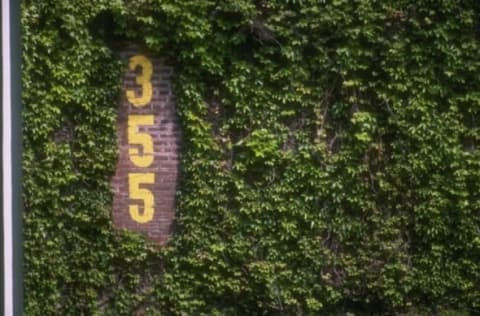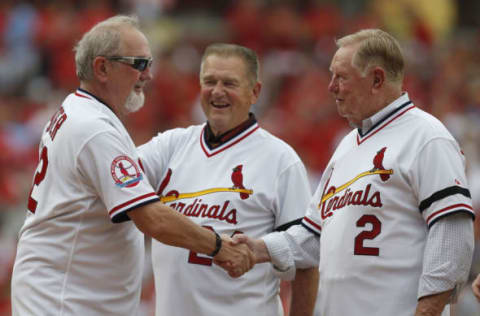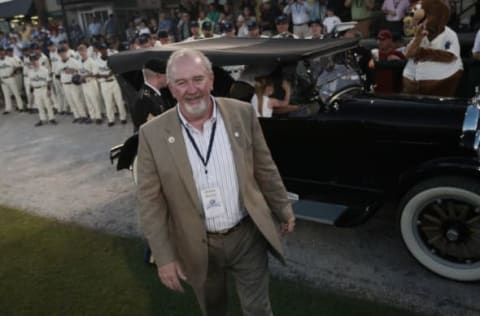Chicago Cubs: The Heroes of Wrigley Series presents Bruce Sutter


Once a struggling minor league pitcher, a pioneering pitch changed his career and made him become one of the game’s best relief pitchers of all-time.
Originally selected in the 21st round by the Washington Senators in the 1970 draft, Bruce Sutter opted to attend Old Dominion University in Virginia instead. He then spent the summer of 1971 playing semi-pro ball in the Lebanon Valley League. It was there where a scout for the Chicago Cubs, who was impressed with the right-hander’s blazing fastball, discovered Sutter and prompted the team to sign the 18-year-old.
That September, Sutter signed as a free agent to play for the Chicago Cubs.
He began his professional career quite auspiciously. After just two games in the minor leagues, Sutter suffered a pinched nerve in his throwing arm, which required surgery.
After recovering from his injury, it quickly became apparent to Sutter that he had lost the fastball that granted him the opportunity to pitch professionally. To troubleshoot the issue, Sutter worked with Fred Martin, the Cubs minor league pitching instructor. Martin introduced him to the pitch that would come to define Sutter’s career.
Sutter learned to throw the split-fingered fastball, a derivation of a forkball. To an opposing batter, the ball would look like a regular run-of-the-mill fastball at first but suddenly spin downwards towards the dirt, deceiving the fooled hitters if thrown correctly.
He took some time to develop and master his new weapon but, once he did, he quickly rose through the ranks of Chicago’s minor league system. He baffled hitters and warranted a call-up to the Show in 1976.
Upon being called up to the Cubs, Sutter was primarily used in mop-up roles for the lowly North Siders. Nonetheless, he showcased his dominance in his first 18 games, recording a microscopic 1.13 ERA.
By July, he became virtually unhittable and took over the club’s closing duties indefinitely.

Chicago Cubs: After revolutionizing a specialty pitch, he set to define a new role in baseball that would be known as a “closer.”
In 1977, his first full season in the Majors, Sutter had one of the greatest seasons in history for a relief pitcher.
The 24-year-old used his patent splitter to strike out 129 batters, posting a 7-3 record with a 1.34 ERA and 31 saves in 62 games over 107 1/3 innings pitched.
The team, itself, found themselves in playoff contention for most of the season in a memorable 1977 run. However, they faded by August which coincided around the time that Sutter landed on the disabled list with a shoulder strain.
Despite the disappointing end to the Cubs promising campaign, Sutter was selected to his first National League All-Star team and put the rest of the NL on notice that he was a force to be reckoned with out of the bullpen.
Again earning an All-Star nod in 1978, Sutter also proved a workhorse out of the Cub bullpen pitching 98 2/3 innings, adding 106 strikeouts and locking down 27 saves in 64 appearances.
He did have 14 blown saves that season, which may seem high in comparison to today’s standards. However, it was fairly common during that era as the newly formed role of the “closer” saw pitchers in that role often enter games sometimes as early as the sixth inning to close out the games.
Perhaps his most memorable season came in 1979 when he led the Majors in saves with 37 and again pitched in over 100 innings for the second time in his career. He also posted a 2.22 ERA and struck out 110 batters en route to capturing the National League Cy Young Award.
In 1980, Sutter, again, led the league in saves with 28 over 102 1/3 innings pitched. However, his strikeout total drastically decreased and, for the first time in three seasons, he failed to eclipse the 100 punch-out mark, striking out only 76.
At the time, Sutter was the highest paid reliever in baseball, even over Rich Gossage, earning a $700,000 arbitration salary. He was looking to sign a long-term deal with Chicago but, unwilling to pay him and fearing he was starting to decline (his low strikeout total as a sign of that), the Cubs instead traded the red-headed closer to the St. Louis Cardinals in exchange for first baseman Leon Durham and third baseman Ken Reitz.
His tenure with the Cubs officially came to an end with the deal in December of 1980 and his new team, the rival Redbirds, promptly signed Sutter to a four-year contract.

Chicago Cubs: Now an established late-inning threat, Bruce Sutter sets his sights on championship gold.
In the strike-shortened 1981 season, Sutter saved 25 games while pitching in 82 1/3 innings. His 2.62 ERA helped him earn another All-Star selection, but his new club fell short of making the playoffs.
Sutter led the league with 36 saves during his sophomore season in St. Louis in 1982. His efforts, which saw him finish 5th in the National League Most Valuable Player rankings, helped the team garner a playoff spot.
In six postseason appearances, Sutter was lights out, combining for six saves and two wins.
In the seventh and deciding game of the 1982 World Series, Sutter entered the game in the eighth inning, St. Louis clinging to a 4-3 lead against the Milwaukee Brewers. The fiery redhead retired six consecutive Brewers to close out the decisive victory and clinching the World Championship for the Cardinals.
Legendary Cardinals manager Whitey Herzog appreciated having Sutter at the back end of his bullpen and touted his makeup to close out ball games.
“I don’t think I’ve ever seen a better relief pitcher. And he had the best makeup of any closer I’ve ever seen. If he didn’t get the job done, you knew he would get it done the next nine times. It was like money in the bank. He just cut the percentages down for me from 27 outs a game to 21.”
The extra workload of the previous season proved to carry over into the 1983 season as Sutter suffered a World Series hangover by not performing to his usual standards. He blew nine saves and saw his ERA balloon to 4.23.
In a move to help Sutter regain his form, the Cardinals hired Mike Roarke, a former Cubs pitching coach, and split-fingered specialist. The move, indeed, proved beneficial as Sutter saved a career-high 45 games. More astonishingly, he lowered his ERA to 1.54 and pitched in a total of 122 2/3 innings. After a two-year absence, he was again selected as a National League All-Star.
A free agent after his miraculous comeback season, Sutter signed a six-year deal with the Atlanta Braves. At the time, the contract was worth $4.8M, but Sutter eventually became much riched from the deal due to a decision that Bobby Bonilla most certainly noticed.

Chicago Cubs: Not throwing as hard as he once did, Sutter knew his best days were in the rearview mirror.
From the beginning of his 1985 season with Atlanta, it became clear that the 32-year-old Sutter had entered the twilight of his career.
More from Cubbies Crib
- Cubs starting pitching has been thriving on the North Side
- Make no mistake: the Cubs are very much about power hitters
- Cubs are giving pitcher Javier Assad a deserved shot
- Cubs: It’s time to start thinking about potential September call-ups
- Cubs: P.J. Higgins deserves to be in the lineup on a daily basis
He struggled immensely and never seemed to sort out his mechanics. He finished the season with only 23 saves and a 4.48 ERA. Never able to get on track, the arm problems that he had suffered during his days in the minor leagues, the same that nearly derailed his career before it even began, reared their head again.
Bothered by a nerve impingement in his shoulder, the injury would require surgery, forcing him to miss the beginning of the 1986 season. Sutter pitched in only 16 games for the Braves, recording a 2-0 record with a 4.34 ERA before re-injuring his arm in May. He was then shut down for the remainder of the year.
A third shoulder surgery required Sutter to miss the 1987 season in its entirety.
Returning in 1988, he pitched in 38 games, tossing for a 4.34 ERA and earning 14 saves in 45 1/3 innings. Sutter’s 14th save of the season served as the 300th of his Major League career, as well as his last ever.
By March of 1989, Sutter was dealing with a severally torn rotator cuff and knew that he had most likely pitched in his last game.
The Braves released Sutter in November of ’89. At the time, he was only 35-years-old.
Sutter, still with guaranteed money left on the table and the Braves needing to clear up room for a rebuild financially, the two parties agreed to a deferred payment with 13 percent interest.
Due to this, just like Bonilla’s deal, which is now a celebrated tongue-in-cheek day and dubbed “Bobby Bonilla Day” every June, Sutter’s restructured deal sees him receive $1.3M annually for 30 years, not ending until 2021.

Chicago Cubs: Rightfully earning his place in Cooperstown, Bruce Sutter is remembered as a baseball pioneer and the first modern-day closer.
Notoriously cold toward relief pitchers, the Hall of Fame didn’t treat Sutter any differently. He spent 12 years on the ballot but received no call. On his 13th chance, he finally did and was inducted in 2006.
Playing only 12 seasons during his brief career, Sutter still managed to win four Rolaids Relief Awards. He also became the first inductee ever in history to have logged fewer than 1,700 innings pitched and also currently just the fourth (Satchel Paige, Rollie Fingers and Trevor Hoffman) to have a losing overall record (68-71).
Many writers have said that his short, injury-riddled career was a factor in his long journey to finally getting into Cooperstown.
Those same writers also admit that his induction was greatly helped by his five strong seasons as a member of the Chicago Cubs. Not just because of his dominance in those years, but his impact on the game acting as a bannerman for a newly formed pitching role that became known as a “closer,” which was new at the time.
Next. Ranking the best single-season pitching performances (Part I). dark
Bruce Sutter was only a Chicago Cub for five seasons from 1976-80. However, in just those few years, he baffled opposing hitters with his devasting split-fingered fastball, a pitch he pioneered and granted him a second chance, on his way to becoming the first true modern closer in baseball history.
His 133 total saves for Chicago still rank as the second most in franchise history, only behind fellow Hall of Fame closer Lee Smith.